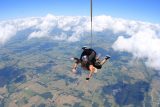People often ask us about skydiving safety, which is totally understandable. If you’re trying something new that you’re unfamiliar with, you may want to know the risks.
Like any sport, there are risks involved with skydiving. But in everything we do, we try to mitigate those risks as much as possible. Skydiving is awesome, and the last thing we want is for you to not enjoy your experience because you’re concerned about safety. Or worse, for you to never experience the joy of skydiving at all!
Is skydiving safe?
Skydiving is an incredibly exciting adrenaline fueled sport that tens of thousands of people across the world enjoy every year.
The sheer volume of skydives that happen across the world means that we have tons of data to show that while the sport has risks, it can be done safely. The USPA (United States Parachute Association) has statistics about how many people jump and how many have problems along the way – we’ll come to this in a bit.
Essentially, skydiving is as safe as it can be. It sounds like a fluffy answer, but we have so many precautions in place to reduce risk that for many, the risk quotient is manageable.
How many people die skydiving?
The short answer to this is ‘hardly any’. When people do sadly die during a skydive, it’s most likely to happen during advanced maneuvers; typically, ‘normal’ skydiving results in even fewer issues.
To answer this one in more detail, let’s go back to the USPA statistics we mentioned earlier.
The USPA recorded a total of 3.5 million jumps in the US in 2015. That includes first-time tandem skydivers and experienced solo skydivers.
Out of those, there were 21 fatal skydiving accidents. This equates to 0.006 fatalities per 1,000 jumps, which is a very small risk.
Tandem skydiving – where you’re attached to an experienced skydiving instructor for your jump – has an even better safety rate, with 0.002 fatalities per 1,000 jumps on average over the past 10 years. Statistically, you’re more likely to die being struck by lightning or stung by a bee.
What are the risks involved?
As we’ve mentioned, the main risks involved with skydiving are related to advanced maneuvers. It’s more likely for issues to occur when someone with thousands of jumps under their belt attempts something new or more advanced than they’ve done before.
One of these maneuvers involves parachute work where the skydiver purposely increases their rate of descent by quickly turning the parachute. The goal of this – known as ‘swooping’ – is that you increase the speed of the parachute as it crosses the ground. If the skydiver gets this wrong, it can result in injuries or fatality.
What this means, in reality, is that ‘normal’ skydives are usually very safe indeed. If you’re learning to skydive, making a tandem jump or an experienced jumper doing an ordinary jump, it’s highly unlikely anything will go wrong.
That said, there are still risks involved with all types of skydiving – and we’ll talk about how we mitigate that in a moment. The main skydiving risks are:
- Parachute malfunctions; around one in 1,000 parachute openings don’t go to plan, with various known malfunctions
- Injury on landing; if tandem students, for example, fail to lift their legs up for landing, they can take the impact through their ankles
- Injury during freefall (usually when jumping with other people, at high speeds, and accidentally taking a knock)
How do we mitigate and manage the risks?
Skydiving training is very military in style. By this, we mean that we have very strict processes and we learn them through repetition and lots of shouting.
The main risk in parachuting is, as described above, parachute malfunctions. When a parachute fails to open correctly, or has an issue such as a broken line, we have very clear processes to handle the situation. Plus, we have a second parachute (a reserve) in the kit, which we deploy once the malfunctioning one is released. It’s something we’re completely prepared for.
For injuries on landing, we train our tandem students to lift their legs, and remind them to do so as we come into land. For experienced jumpers, we learn something called a ‘PLF’, or parachute landing fall, which takes the impact away from our ankles and allows us to roll it off.
For injuries during freefall, we have something called an AAD, which stands for ‘automatic activation device’. This is a small electronic device that monitors our rate of descent and altitude; if we are falling at a freefall speed by a height at which we really should be under our parachutes, the AAD automatically deploys the reserve parachute for us. This means that, if we are unable to deploy our main parachute for any reason, it is opened for us.
There have also been a lot of improvements in skydiving technology in recent years. From the parachutes we fly to the AADs to the audible altitude devices we use, everything has been developed to make skydiving safer than ever before.
If you’re coming to us to make a tandem skydive, you’ll learn more about the tandem equipment during a 20-30 minute brief prior to your jump.
If you do have any questions about skydiving safety, feel free to get in touch and a member of our team will be happy to help.


